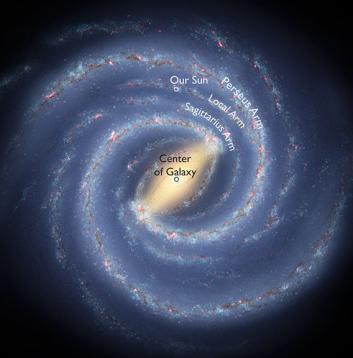I do love a good Milky Way picture, especially when the composition, the foreground, is something striking or unexpected. Photographer Michael Shainblum (whom you may remember from the time-lapse animations “Existence” and “Into the Atmosphere,” as well as a previous Milky Way photo I featured here) has done just such a thing, taking a lovely shot of our galaxy apparently rising out of the ocean:

Photo by Michael Shainblum, used by permission
He was in Gaviota, Calif., when he took this shot in April 2013. He used a fish-eye lens, which is why the normally straight glow of the Milky Way appears curved. The 30 second exposure blurred and softened the incoming waves from the Pacific Ocean, somewhat appropriately giving a milky feel to them. My eye was drawn to the rocks there; the long sheets of sedimentary layers tilted at an angle, presumably laid down flat millions of years ago and then later canted by the rock uplifted to the left (north).
The huge scale of this picture (it spans a third of the way across the sky) makes it hard to pin down some of the stars, but the bright one on the right is Antares in Scorpius, the bright pink patch of fuzz near the Milky Way’s center is the famous Lagoon Nebula, and to the upper left is the bright blue spark of Vega

Illustration by Robert Hurt, IPAC; Bill Saxton, NRAO/AUI/NSF
I’m commonly asked what it means to see the Milky Way in the sky. Our galaxy is a flat disk, and we are inside that disk, about halfway from the center to the edge. When we look toward the galactic center, it’s like being in the suburbs and looking toward the downtown region; there are more lights in that direction, and it’s brighter there. Since the galaxy is flat, we see it as a thick stream of light across the sky, like milk spilled by the gods across the heavens. That’s why it’s called the Milky Way; we mean both the way it appears in the sky as well as the galaxy itself (you can usually tell which one astronomers mean by the context). The word “galaxy” is derived from the Latin for milk!
The thickening at the middle is called the hub or bulge, and we see it in other disk galaxies, which is another strong bit of evidence we live in such a galaxy. We also know about our galaxy’s spiral arms by looking out into it using radio telescopes and measuring the velocities and positions of giant clouds of gas; they trace the structure of the Milky Way’s magnificent spiral.
Pictures like Shainblum’s are certainly beautiful, but they also hint at the depth and nature of the Universe. It’s like a code, or a puzzle, with the pieces gathered and just waiting to be assembled. That’s one of the many reasons I love science! It helps us see the bigger picture.